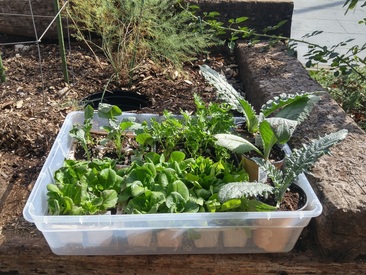 These $4 trays keep seedlings corralled for easy watering and moving, including enabling reabsorption of water that initially ran through potting mix.
These $4 trays keep seedlings corralled for easy watering and moving, including enabling reabsorption of water that initially ran through potting mix. I’d just purchased a batch of tiny lettuce, spinach, chard, kale, cilantro, parsley, and artichoke seedlings from my favorite provider, San Gabriel Nursery, a couple of days ago. But by about noon yesterday, they were all drooping, so I had to move them into afternoon shade and water them again.
I’ve found plastic storage trays to be ideal for grouping six-packs and 4” pots, keeping them watered and easily moved in bulk between locations as needed. They’re about $4 from Target.
After another two weeks of acclimation to my garden and their new home, I’ll transplant them.
In the meantime, I’ll prepare the soil in the bed where they’ll mature. I’ll pile on about an inch of manure, another inch of compost, some coffee grounds, and a scattering of Dr. Earth fertilizer with about even numbers of N-P-K. Then, using a hand trowel, I’ll turn it all in with the top inch of original soil in the bed. I don’t want to dig deeper so I don’t disturb the understory soil that’s become full of microorganisms that’ll help the new transplants connect with their established supporting networks.
This is done two to three weeks before I’ll sow seeds or transplant seedlings there so the heat-up of the new mix can be accomplished and cooled down back to regular temperature before adding the new plants. If you don’t wait, chances are the new roots will be burned, and seeds sown may not germinate.
Why Sow Seeds and Transplant Seedlings Now?
Seeds sown now for winter and spring blooms and crops – especially edible peas and flowering sweet peas – and transplanting perennials like artichokes, asparagus, rhubarb, strawberries, and California natives – will encourage strong root and foliar development that will survive most frosts, thrive, and bear food and flowers sooner. Especially during our continuing drought, best establishment practices will assure long productive plant life!
Sow or transplant two or three times the amount you would in spring, as these overwintering crops will grow very slowly. For salad greens like lettuce and spinach and bok choy, you’ll harvest only a couple of leaves a week from each plant, so you’ll need many more plants to result in frequent salads.
Thanksgiving is my area’s average first frost date, although it’s been several years since my garden has had any frost at all.
Plants that have developed deep root systems and mature leaves are more tolerant to the cold. When these plants are three or four inches in size before the first hard frost, they're mature enough to be harvested throughout the fall, winter, and early spring.
These will bolt at the first real warmth of early spring, though, so they can't be counted on to provide a crop after that. But, by then, you'll have made the first spring plantings, so the gap between harvests won't be too long.
When sowing cover crops for the fall and winter, consider edible ones. Kale and rocket (roquette, arugula) are full-flavored leafy vegetables that withstand freezing. Both germinate in cool weather and are welcome fresh greens for stir-fry and soups all winter long. In the spring, they can be easily turned under as "green manure" when preparing the soil for the main spring and summer crops.

 RSS Feed
RSS Feed